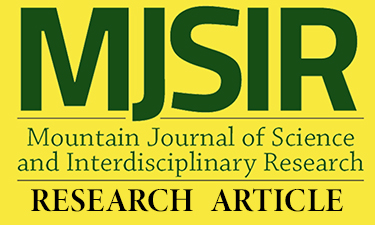Stress and Coping Strategies of University Employees in Buguias, Benguet
Main Article Content
Abstract
Stress affects employees’ productivity if not recognized early and managed properly. The study determined the stress levels of university employees, the effects of stress on them, and their coping mechanisms along physical, emotional, psychological, social, and spiritual aspects. It also explored the correlation of demographic profiles with stress levels and the extent of use of coping strategies. The study used a survey questionnaire and correlation. Results revealed that university employees commonly experienced moderate work-related and individual-related stress levels. The effects of stress across the four dimensions were experienced only at times and slightly affected the employees’ performance. Spiritual coping strategies were the most utilized. Employees with a higher net monthly take-home pay, female employees with a lack of professional respect and involvement in decision making, faculty members faced with life crisis issues, and single employees with poor health issues report higher stress levels. Faculty members tend to lose their appetite when confronted with taxing situations, while female employees are likely to become disoriented in school activities. To cope with stressors, single employees and those who have rendered services for 11 years and above utilized listening to soothing music and doing relaxation techniques. This study concludes that employees’ stress at this university is still manageable and within their control. Wellness policies and revitalized wellness programs may still be formulated and implemented to address workplace stress.
Article Details
References
Amble, B. (2006). Asia worse hit by global stress epidemic. Management.Issues. http://www.management-issues.com/news/3019
American Psychological Association (2011). 2011 Stress in America: The Impact of Stress. https://www.apa.org/news/press/releases/stress/2011/impact
American Institute of Stress. (2018). Worrisome workplace statistics: facts, causes, and trends. http://www.stress.org/workplace-stress
Ansis, J.C. (2017). Filipinos cite job, studies as top cause of stress. CNN. https://www.cnnphilippines.com/lifestyle/2015/09/23/Filipinostopcauses-of-stress-job-traffic-money.html
Baqutayan, S.M. (2015). Stress and coping mechanisms: A historical overview. Mediterranean Journal of Social Sciences, 6(21): 479-485. https://www.researchgate.net/publi cation/276847037
Beers, J. (2012). Teachers' stress and coping: does the process differ according to years of teaching. Published Dissertation. https://pdxscholar.library.pdx.edu/open_access_etds/809/
Betonio, J. (2015). Stress factors and teaching performance of the college faculty. International Journal of Social Science and Humanity, 5(7): 651-655. http://www.ijssh.org/index.php?
CFO Innovation (2012). Work is the top trigger of stress for Asia-pacific workers. https://www.cfoinnovation.com/
Civil Service Commission. (1992). Commission MC No. 38, s. 1992 on physical and mental fitness program for government personnel. https://oshc.dole.gov.ph/wp-content/uploads/ 2021/05/CSC-MC-38-s-1992.pdf
Cohen, S., Doyle, W., & Baum, A. (2006). Socioeconomic status is associated with stress hormones. Psychosomatic Medicine, 68(3): 414420. https://journals.lww.com/
Cox, T., Griffiths, A., & Leka, S. Work Organization and Work-Related Stress. (2003). In: Gardiner, K., & Malcolm Harrington, J. (2005). Occupational Hygiene, Third Edition. https://doi.org/10.1002/9780470755075.ch28
Cummings, J.P., & Pargament, K.I. (2012). Religious coping with workplace stress. In P.C. Hill & B.J. Dik (Eds.), Psychology of religion and workplace spirituality (pp. 157–177). IAP Information Age Publishing.
Feldman, R.S. (2008). Essentials of Understanding Psychology 7th Edition. New York, USA: McGrawHill International Companies Inc.
Fink, G. (2016). Stress: the health epidemic of the 21st century. Elsevier SciTech Connect. https://scitechconnect.elsevier.com/stresshealthepidemic-21st-century/
Gupta, A., & Chandwani, R. (2008). Job stress and performance. Tejas@immb. Indian Institute of Management, Bangalore. https://tejas.iimb.ac.in/articles/24.php
International Labor Organization (2016). Workplace stress: a collective challenge. Geneva, Switzerland: International Training Centre of the ILO.
Iyi, O.E. (2015). Stress management and coping strategies among nurses. Unpublished Thesis. https://www.theseus.fi/bitstream/handle/10024/102221/Thesis-%20Obiora.pdf;%20sequence=1
Juster, R.P. (2009). Mind-body differences in distress and stress reactivity among the sexes. Mammoth Magazine, Issue 6. 7-8. https://humanstress.ca/Documents/pdf/Mammouth-Magazine/
Mills, H., Reiss, N., & Dombeck, M. (2008). Religious/spiritual practice for stress reduction. https://www.mentalhelp.net/articles/
Mingoa, T. (2017). Filipino teachers’ stress levels and coping strategies. DLSU Research Congress. https://xsite.dlsu.edu.ph/
Olatunji, S., & Mokuolo, B. (2014). The influence of sex, marital status, and tenure of service on job stress and job satisfaction of health workers in a Nigerian federal health institution. African Research Review International Multidisciplinary Journal, 8(1): 6-8. https://www.ajol.info/index.php/afrrev/article/view/101335
Pestaňo, J., Avena, B., & Bejar, T. (2009). Personal responses to stress; the case of the non-teaching employees of the University of the Cordilleras. University of the Cordilleras Research Journal, 1(3): 27-30. http://citeseerx.ist.psu.edu/viewdoc/ summary
Prachi, J. (2010). Employee stress - strategies for managing stress at workplace. http://www.managementstudyguide.com/
Rappler. (2016). For Pinoys, this is the leading cause of stress at work. http://www.rapler.com
Robinson, L., Smith, M., & Segal, R. (2011). Stress Management: How to Reduce, Prevent, and Cope with Stress. https://www.brainline.org/
Robinson, L., Smith, M., & Segal, R. (2018). Stress management. https://www.helpguide.org/articles /stress
Roxas, C. (2009). Stress among Public Elementary School Teachers. University of the Cordilleras Research Journal, 1(3). http://citeseerx.ist.psu.edu/viewdoc/summary?doi=10.1.1.683.3910
Sharma, S., & Kaur, R. (2013). The effect of demographic factors on occupational stress. A study of insurance sector. Annual Journal, 4: 6082. http://www.publishingindia.com/GetBro chure.aspx?query=UERGQnJvY2h1cmVzfC8xO Dk5LnBkZnwvMTg5OS5wZGY=
Selye H. (1973). The evolution of the stress concept.
American Scientist, 61(6): 692-699. https:// psycnet.apa.org/record/1974-10586-001
Stahlmann, J., & Hagaman, J. (2016). Not all stress is bad. https://www.montgomeryadvertiser.com/
Tan, J.S.T. (2017). Factors affecting stress among faculty members of public universities in the Philippines: a multiple regression analysis. International Journal of Psychological Studies, 9(3): 64-66. https://doi.org/10.5539/ijps.v9n3p64
Tan, M.L. (2006). Stress and the Filipino. Philippine Center for Investigative Journalism. https:// old.pcij.org/stories/stress-and-the-filipino/
Tasker, S. (2017). Workplace stress affects 73 percent of employees. https://www.theaustralian.com.au/life/
World Health Oganization. (2003). Work organization and stress: systematic problem approaches for employers, manages and trade union representatives. https://www.who.int/iris/handle/10665/42625

